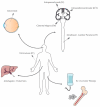Gene Therapy for Lysosomal Storage Disorders: Ongoing Studies and Clinical Development
- PMID: 33924076
- PMCID: PMC8074255
- DOI: 10.3390/biom11040611
Gene Therapy for Lysosomal Storage Disorders: Ongoing Studies and Clinical Development
Abstract
Rare monogenic disorders such as lysosomal diseases have been at the forefront in the development of novel treatments where therapeutic options are either limited or unavailable. The increasing number of successful pre-clinical and clinical studies in the last decade demonstrates that gene therapy represents a feasible option to address the unmet medical need of these patients. This article provides a comprehensive overview of the current state of the field, reviewing the most used viral gene delivery vectors in the context of lysosomal storage disorders, a selection of relevant pre-clinical studies and ongoing clinical trials within recent years.
Keywords: gene therapy; lysosomal diseases; viral vectors.
Conflict of interest statement
The authors declare no conflict of interest.
Figures


References
Publication types
MeSH terms
Grants and funding
LinkOut - more resources
Full Text Sources
Other Literature Sources
Medical

